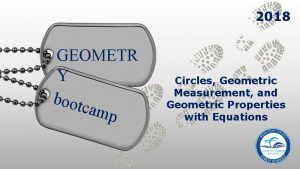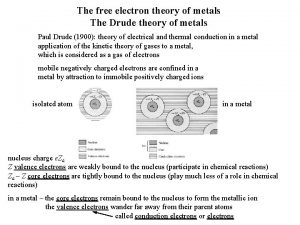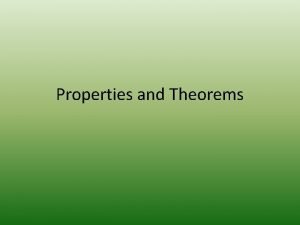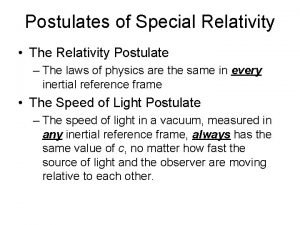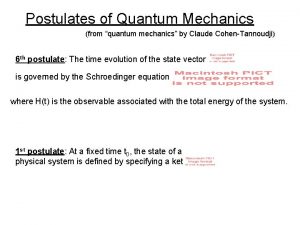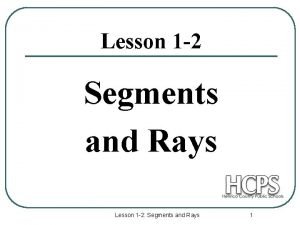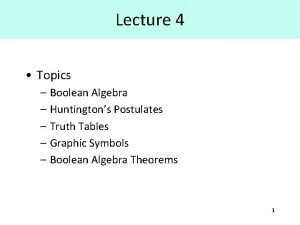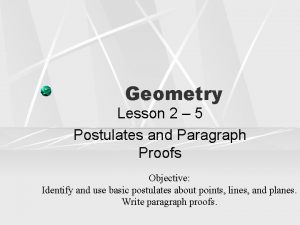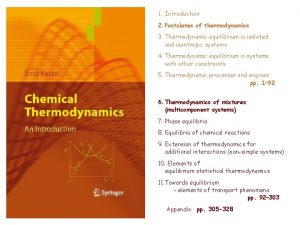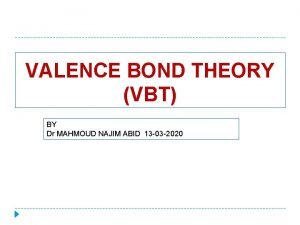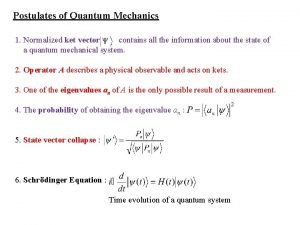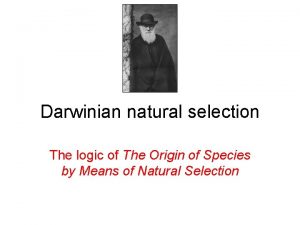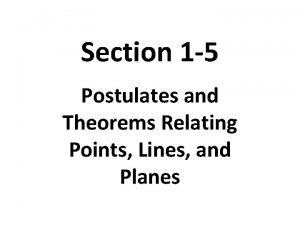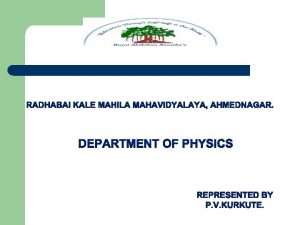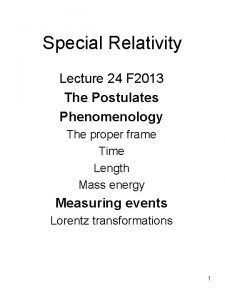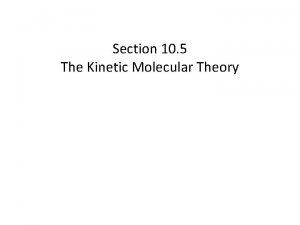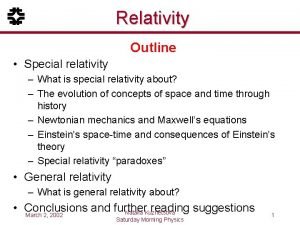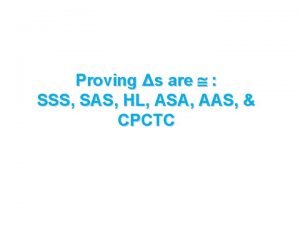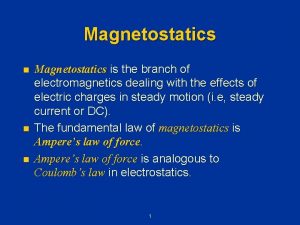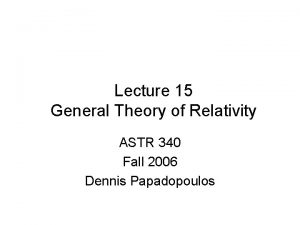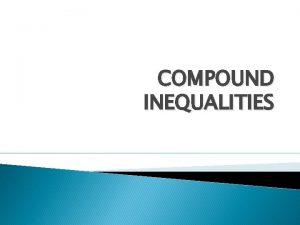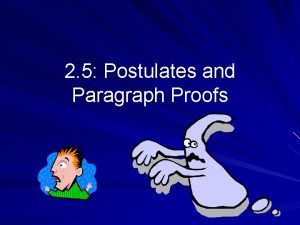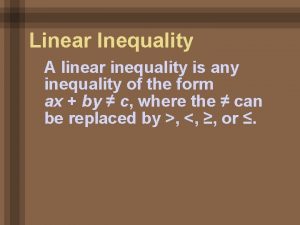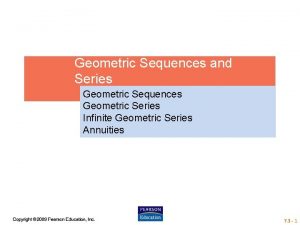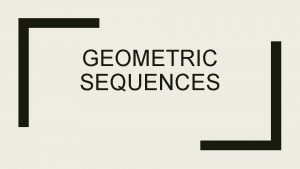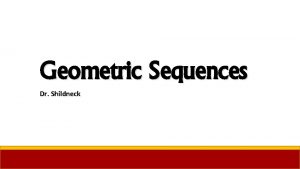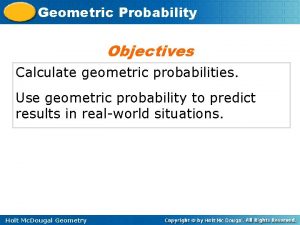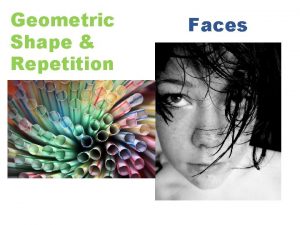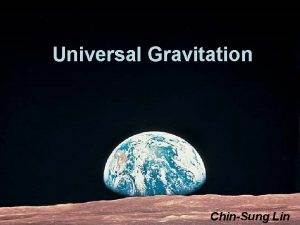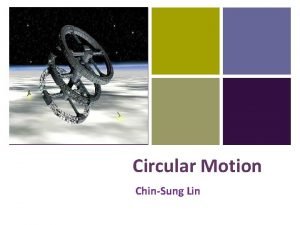Chapter 7 Geometric Inequalities ChinSung Lin Inequality Postulates




































- Slides: 36

Chapter 7 Geometric Inequalities Chin-Sung Lin

Inequality Postulates Mr. Chin-Sung Lin

Basic Inequality Postulates Comparison (Whole-Parts) Postulate Transitive Property Substitution Postulate Trichotomy Postulate Mr. Chin-Sung Lin

Basic Inequality Postulates Addition Postulate Subtraction Postulate Multiplication Postulate Division Postulate Mr. Chin-Sung Lin

Comparison Postulate A whole is greater than any of its parts If a = b + c and a, b, c > 0 then a > b and a > c Mr. Chin-Sung Lin

Transitive Property If a, b, and c are real numbers such that a > b and b > c, then a > c Mr. Chin-Sung Lin

Substitution Postulate A quantity may be substituted for its equal in any statement of inequality If a > b and b = c, then a > c Mr. Chin-Sung Lin

Trichotomy Postulate Give any two quantities, a and b, one and only one of the following is true: a < b or a = b or a > b Mr. Chin-Sung Lin

Addition Postulate I If equal quantities are added to unequal quantities, then the sum are unequal in the same order If a > b, then a + c > b + c If a < b, then a + c < b + c Mr. Chin-Sung Lin

Addition Postulate II If unequal quantities are added to unequal quantities in the same order, then the sum are unequal in the same order If a > b and c > d, then a + c > b + d If a < b and c < d, then a + c < b + d Mr. Chin-Sung Lin

Subtraction Postulate If equal quantities are subtracted from unequal quantities, then the difference are unequal in the same order If a > b, then a - c > b - c If a < b, then a - c < b - c Mr. Chin-Sung Lin

Multiplication Postulate I If unequal quantities are multiplied by positive equal quantities, then the products are unequal in the same order c > 0: If a > b, then ac > bc If a < b, then ac < bc Mr. Chin-Sung Lin

Multiplication Postulate II If unequal quantities are multiplied by negative equal quantities, then the products are unequal in the opposite order c < 0: If a > b, then ac < bc If a < b, then ac > bc Mr. Chin-Sung Lin

Division Postulate I If unequal quantities are divided by positive equal quantities, then the quotients are unequal in the same order c > 0: If a > b, then a/c > b/c If a < b, then a/c < b/c Mr. Chin-Sung Lin

Division Postulate II If unequal quantities are divided by negative equal quantities, then the quotients are unequal in the opposite order c < 0: If a > b, then a/c < b/c If a < b, then a/c > b/c Mr. Chin-Sung Lin

Theorems of Inequality Mr. Chin-Sung Lin

Theorems of Inequality Exterior Angle Inequality Theorem Greater Angle Theorem Longer Side Theorem Triangle Inequality Theorem Converse of Pythagorean Theorem Mr. Chin-Sung Lin

Exterior Angle Inequality Theorem The measure of an exterior angle of a triangle is always greater than the measure of either remote interior angle Given: ∆ ABC with exterior angle 1 B Prove: m 1 > m A m 1 > m B 1 A C Mr. Chin-Sung Lin

Exterior Angle Inequality Theorem B A Statements 1 C Reasons 1. 1 is exterior angle and A & B are remote interior angles 1. Given 2. m 1 = m A +m B 2. Exterior angle theorem 3. m A > 0 and m B > 0 4. m 1 > m A m 1 > m B 3. Definition of triangles 4. Comparison postulate Mr. Chin-Sung Lin

Longer Side Theorem If the length of one side of a triangle is longer than the length of another side, then the measure of the angle opposite the longer side is greater than that of the angle opposite the shorter side (In a triangle the greater angle is opposite the longer side) C Given: ∆ ABC with AC > BC Prove: m B > m A B A Mr. Chin-Sung Lin

Longer Side Theorem If the length of one side of a triangle is longer than the length of another side, then the measure of the angle opposite the longer side is greater than that of the angle opposite the shorter side (In a triangle the greater angle is opposite the longer side) C Given: ∆ ABC with AC > BC Prove: m B > m A 2 1 B 3 D A Mr. Chin-Sung Lin

C Longer Side Theorem Statements 1 B 2 3 D A Reasons 1. AC > BC 1. Given 2. Choose D on AC, CD = BC and 2. Form an isosceles triangle draw a line segment BD 3. m 1 = m 2 4. m 2 > m A 5. 6. 7. 8. m 1 m B m B > = > > m A m 1 + m 3 m 1 m A 3. Base angle theorem 4. Exterior angle is greater than the remote int. angle 5. Substitution postulate 6. Partition property 7. Comparison postulate 8. Transitive property Mr. Chin-Sung Lin

Greater Angle Theorem If the measure of one angle of a triangle is greater than the measure of another angle, then the side opposite the greater angle is longer than the side opposite the smaller angle (In a triangle the longer side is opposite the greater angle) Given: ∆ ABC with m B > m A Prove: AC > BC B C A Mr. Chin-Sung Lin

C Greater Angle Theorem B Statements 1. 2. 3. 4. A Reasons m B > m A Assume AC ≤ BC m B = m A (when AC = BC) m B < m A (when AC < BC) 1. Given 2. Assume the opposite is true 3. Base angle theorem 4. Greater angle is opposite the longer side 5. Statement 3 & 4 both contraidt 5. Contradicts to the given statement 1 6. AC > BC 6. The opposite of the assumption is true Mr. Chin-Sung Lin

Triangle Inequality Theorem The sum of the lengths of any two sides of a triangle is greater than the length of the third side Given: ∆ ABC Prove: AB + BC > CA C B A Mr. Chin-Sung Lin

Triangle Inequality Theorem The sum of the lengths of any two sides of a triangle is greater than the length of the third side Given: ∆ ABC Prove: AB + BC > CA C 1 D B A Mr. Chin-Sung Lin

Triangle Inequality Theorem C 1 Statements D B 1. Let D on AB and DB = CB, and connect DC 2. m 1 = m D 3. m DCA = m 1 + m C 4. m DCA > m 1 5. m DCA > m D 6. AD > CA 7. AD = AB + BD 8. AB + BD > CA 9. AB + BC > CA A Reasons 1. Form an isosceles triangle 2. Base angle theorem 3. Partition property 4. Comparison postulate 5. Substitution postulate 6. Longer side is opposite the greater angle 7. Partition property 8. Substitution postulate Mr. Chin-Sung Lin

Converse of Pythagorean Theorem A corollary of the Pythagorean theorem's converse is a simple means of determining whether a triangle is right, obtuse, or acute Given: ∆ ABC and c is the longest side Prove: If a 2 +b 2 = c 2, then the triangle is right If a 2 + b 2 > c 2, then the triangle is acute If a 2 + b 2 < c 2, then the triangle is obtuse C B A Mr. Chin-Sung Lin

Triangle Inequality Exercises Mr. Chin-Sung Lin

Exercise 1 ∆ ABC with AB = 10, BC = 8, find the possible range of CA Mr. Chin-Sung Lin

Exercise 2 List all the line segments from longest to shortest D 59 o A 60 o 61 o 59 o 60 o C 61 o B Mr. Chin-Sung Lin

Exercise 3 Given the information in the diagram, if BD > BC, find the possible range of m 3 and m B C 30 o A 30 o 1 2 D 3 B Mr. Chin-Sung Lin

Exercise 4 ∆ ABC with AB = 5, BC = 3, CA = 7, (a) what’s the type of ∆ ABC ? (Obtuse ∆? Acute ∆? Right ∆? ) (b) list the angles of the triangle from largest to smallest Mr. Chin-Sung Lin

Exercise 5 ∆ ABC with AB = 5, BC = 3, (a) if ∆ ABC is a right triangle, find the possible values of CA (b) if ∆ ABC is a obtuse triangle, find the possible range of CA (c) if ∆ ABC is a acute triangle, find the possible range of CA Mr. Chin-Sung Lin

Exercise 6 Given: AC = AD Prove: m 2 > m 1 C 2 A 1 3 D B Mr. Chin-Sung Lin

The End Mr. Chin-Sung Lin
 1-6 solving compound and absolute value inequalities
1-6 solving compound and absolute value inequalities 2018 geometry bootcamp answers
2018 geometry bootcamp answers Free electron model of metals
Free electron model of metals Einstein's postulates
Einstein's postulates Angle postulates and theorems
Angle postulates and theorems Chemistry
Chemistry Angle theorems list
Angle theorems list Postulates of special relativity
Postulates of special relativity Postulates of quantum mechanics
Postulates of quantum mechanics Phenotypic characteristics of bacteria
Phenotypic characteristics of bacteria Opposite rays definition
Opposite rays definition Postulates examples
Postulates examples Boolean postulates
Boolean postulates Koch's postulates exceptions
Koch's postulates exceptions Pasteurization
Pasteurization 2-4 practice writing proofs answers
2-4 practice writing proofs answers Koch's postulates exceptions
Koch's postulates exceptions Exception of koch postulates
Exception of koch postulates Postulates of thermodynamics
Postulates of thermodynamics Vbt ppt
Vbt ppt Postulates of quantum theory
Postulates of quantum theory Jural postulates
Jural postulates Beak depth finches
Beak depth finches Cannon's postulates
Cannon's postulates A plane contains at least _____ point/s
A plane contains at least _____ point/s Theory of evolution summary
Theory of evolution summary Kinetic theory postulates
Kinetic theory postulates Postulates of special theory of relativity
Postulates of special theory of relativity Postulates of special theory of relativity
Postulates of special theory of relativity Angle angle similarity
Angle angle similarity Write postulates of kinetic theory of gases
Write postulates of kinetic theory of gases Special relativity
Special relativity Postulates of quantum mechanics
Postulates of quantum mechanics Aas
Aas Paragraph proof geometry
Paragraph proof geometry Postulates of magnetostatics
Postulates of magnetostatics Eddington
Eddington

